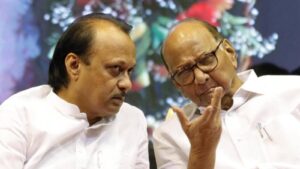After NCP split, Western Maharashtra poll battle expected to turn consequential

Pune: Barely 48 hours before parts of western Maharashtra went to vote in the Lok Sabha election this May, 84-year-old Sharad Pawar looked fatigued, his voice was a hoarse whisper from a long and arduous campaign. However, on June 4 as the results came in heralding a win for Pawar in eight out of the ten seats his party contested, including the prestige seat of Baramati, he was again a charged, re-energised man.

As Maharashtra goes to polls on November 20, all eyes in the Maha Vikas Aghadi will again be on Sharad Pawar and the 70 seats in Western Maharashtra. The region is expected to be a key battleground that could shape state’s future for the next five years. Spread across Pune, Satara, Sangli, Solapur, Kolhapur, and Ahmednagar, this agriculturally rich region has long been a stronghold for political heavyweights. However, with the recent split in the Nationalist Congress Party (NCP) and the Bharatiya Janata Party (BJP) eyeing a comeback, the stakes are higher than ever.
Traditionally, Western Maharashtra has been a bastion for the undivided NCP and the Congress. However since 2014, the BJP, buoyed by Modi’s influence, has been challenging the Congress-NCP combine. In the 2019 assembly polls, the Sharad Pawar-led NCP won 27 seats, the BJP took 20 seats, Congress secured 12, another five went to the undivided Shiv Sena while other contenders, including Surajya Janashakti and independents, picked up the remaining seats.
This election however presents a more complex picture with the NCP divided between the Sharad Pawar and Ajit Pawar factions, and both are striving to consolidate power and reclaim influence in the region. The Sharad Pawar faction has already poached leaders from the BJP and the rival NCP faction, with key figures like Harshavardhan Patil and Samarjit Ghatge switching from BJP, alongside NCP’s Phaltan MLA Deepak Chavan and Sanjeevraje Naik Nimbalkar.
“We are confident of winning the polls and have high expectations from Western Maharashtra. This region has largely backed Sharad Pawar,” said Jayant Patil, state unit chief of NCP (SP) after the announcement of election date.
Ajit Pawar’s decision to align with the BJP-led coalition in 2023 has added a new twist, pitting the two factions against each other in a region traditionally under NCP’s cooperative and political patronage. The setback in the Lok Sabha polls earlier this year, when Ajit’s wife, Sunetra Pawar lost to Supriya Sule in Baramati, has further intensified the rivalry. This defeat has only deepened the stakes for the NCP (AP) faction.
“Our work is before the people of Maharashtra—historic budget, development record, the Ladki Bahin Yojana, three free cylinders, electricity bill waivers for farmers. All my colleagues in Rashtrawadi Congress have worked tirelessly to take our schemes to the people and ensure high enrolment in the Ladki Bahin Yojana. It is now time for us to go to the people, door to door, with folded hands, and ask for their vote,” said Ajit Pawar, who currently serves as the deputy chief minister.
Political analysts argue that this election will not only be crucial in determining the state’s leadership but also in establishing which Pawar faction commands public backing in Western Maharashtra.
“As far as Western Maharashtra is concerned, this election will decide which of the two NCP factions has the people’s mandate. Although the Lok Sabha election was fought after the split of NCP and Shiv Sena, those elections were driven by national issues. This election, however, will be the true test for both factions here,” said political analyst Abhay Deshpande.
The Mahayuti alliance, which includes BJP, Shiv Sena, and Ajit Pawar’s NCP faction, faces an uphill task after a disappointing performance in the Lok Sabha elections, where they won only four of twelve seats in Western Maharashtra. In contrast, the Maha Vikas Aghadi comprising NCP (SP), Shiv Sena (UBT), and Congress won eight seats.
Due to the array of competing factions and the influence of local cooperative networks, most seats are expected to witness multi-cornered fights. “Given the cooperative sector’s influence, the sugar movement, and the higher political ambitions in Western Maharashtra, we are likely to see more rebels in the fray than usual and these candidates could potentially disrupt the plans of the major parties,” Deshpande added.
The recent assembly elections in Haryana have shown how independent candidates and rebels with strong local followings could impact the chances of candidates from established parties. How various parties address issues of unemployment and farm distress arising from excess rainfall, will also be key.



